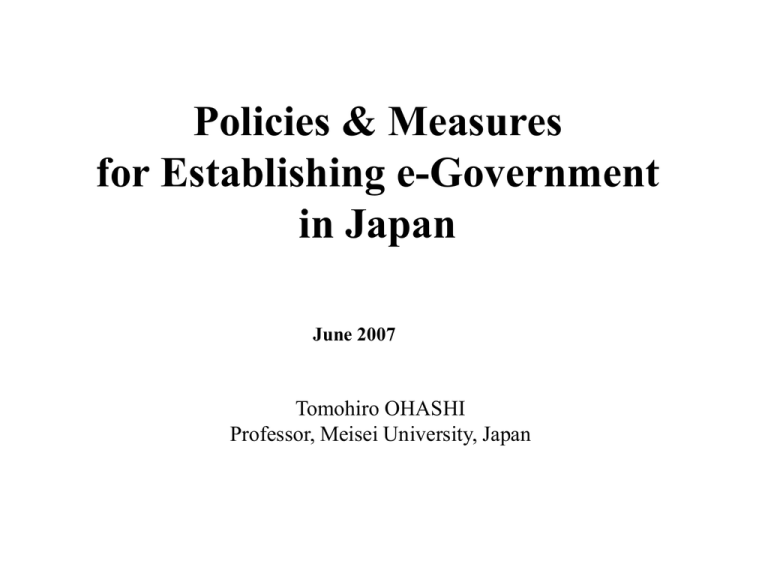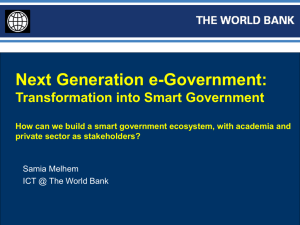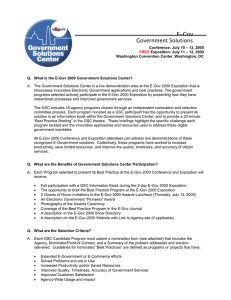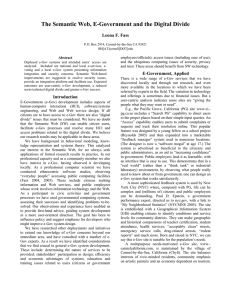Lecture 1
advertisement

Policies & Measures for Establishing e-Government in Japan June 2005 June 2007 Tomohiro OHASHI Professor, Meisei University, Japan CONTENTS 1. What is an e-Government ? 2. Objectives of e-Gov 3. Measures 4. Administrative reform and e-Gov. 5. Legal Aspects of e-Gov 6. Success Factors 7. Difficulties 8. Program for Creating the Next-Generation e-Gov 9. Concepts of Next-Generation e-Gov. 10. Policy for IT education 1. What is e-Government ? In an e-Government There is no ( There is no ( There is no ( There is no ( There is no ( There is no ( ). ). ). ). ). ). Seamless Public administration by ICT Paper based documentation ⇒ multi-media ⇒ media free ⇒ inter-ministerial electronic document exchange specified office hour ⇒ 24 hour service “nonstop-service” designated place for specified service / designated administrative area ⇒ any place / any office for any service ⇒ virtual public office ⇒ cyber-government Specified service ⇒ access point for many types of services ⇒ one-stop service public service at city halls ⇒ at home / office vertical hierarchy ⇒ horizontal flat organization regulation⇒ de-regulation / privatization / outsourcing Three Major Projects of e-Government in Japan e-application e-delivering of gov Doc. e-office to contents 2. Objectives of e-Gov Convenience Efficiency Higher Quality of Services Objectives of e-Gov. 1) Convenience four types of services delivering One-stop Services None-stop Services Any-stop services No-stop services Accessibility of information Improvement of Access to Public Services One-stop Services Non-stop Services Any-stop Services No-stop Services One-stop Services 4 basic records of resident registration in various applications registrations / reporting to several organs one license related to several administrative organs Update of address Electronic Integrated (single) Counter Services Non-stop Services 24 hours ATM delivering machines of resident registration certificates information kiosks public services through the Internet Any-stop services passports at post offices / city halls resident registration certificates at any city update of drivers licenses at post offices No-stop Services New Types of Public Services Hyper-kiosks in Street Corners / Convenience Stores Public Services in Homes or Offices Update of drivers licenses through the Internet 2. Objectives of e-Gov. (continued) 2) Efficiency quick service time saving burden reduction cost saving 3) Higher Quality of Public Services to contents 3. Measures e-application; administrative procedures e-delivery; gov information to the public e-office; efficient administrative activities 3. Measures (continued) e-application Application from offices or homes Many types of proc. & enormous applications (billions a year in Japanese gov) Time and manpower saving Quick services 3. Measures (continued) e-delivery of info. Full use of gov-owned information Openness to the public Transparency Accountability Participation of people 3. Measures (continued) e-office Efficient administrative activities Paper-less: electronic document management e-procurement e-routine work: accounting, personnel management, documentation, procedures e-file/paper in Japanese Gov. (central Gov.) 100% 90% 80% 70% 60% 50% 40% 30% 20% 10% 0% 97 98 99 2000 2001 year paper electronic file 2002 2003 Public Services of e-Gov and e-Local Governments online administrative procedures anything one-stop service of motor vehicle possession Passport at post office anytime anywhere Application for public facility utilization Public gazette in the Internet Resident registration certificate at any city hall Annual global e-government study by Accenture 2002年度 e-Gov.進捗度評価比較 % 70 60 50 40 30 20 10 0 1 2 3 6 7 8 9 10 4 5 11 12 13 14 15 16 17 18 19 20 21 22 23 カ シ ア オ デ イ フ 香 ド ア オ フ ノ ニ ス ベ 日 ポ ブ マ イ 南 メ ル 本 8: 1: Canada Singapore Denmark UK 7: Finland Kong Germany ィ 4:Australia ラ ル 6:ュ キ ナ ン 2:メ ギUS ラ レ タ9: ア ー ン 3: ル Hong 港 イ イ 5:ラ ー ペ ト ジ ー リ フ シ ダ ガ リ ス マ リ ン ツ ル ン ン ウ ジ イ ギ ラ French 13: ン ー シ Belgium ラ Norway ポ 11: カ Netherlands ダ ス 14: ト ー ス 12: ル 16: ア リ コ 10: Ireland Zealand 15:ガSpain ェ New ー ン ー ア ン ル ー ラ ク カ ド ラ ド リ ル 17: Japan 18: Portuguese 19: Brazil 20: Malaysia 21: Italy ン 22: South Africa 23: Mexico ア ド Innovative 先駆的リーダー leaders Visionary ビジョナリ-チャレンジャ followers ー Emerging エマージングパフォーマ performers ー builders プPlatform ラ ッ トフォームビルダ ー to contents 4. Administrative Reform and e-Government Administrative Reform and e-Gov. e-gov supports administrative reform e-gov requires administrative reform simplification of administrative procedures organizational re-structure outsourcing 4. Administrative Reform and e-Gov. (continued) Simplification of administrative procedures Reduction of no. of proc. Abolishing unnecessary proc. Integrating related proc. Avoiding duplicated proc. & forms Reduction of times of filing ex. two times a year ⇒once a year or once in two years e-Japan Action Plan July 2002 Number of administrative procedures No. of Proc. Proc. of National Gov. Proc. of Local Gov. Proc. of Public Corporations total Online by Mar. 2004 ratio 13,589 13,299 98% 5,863 5,636 96% 1,610 1,529 95% 21,062 20,464 97% 4. Administrative Reform and e-Gov. (continued) Many Types of Electronic Procedures Filing, Applications & Reporting Preservation of Documents Disclosure of Public Documents Electronic Document Management Electronic Procurement Electronic Data Exchange; EDI Electronic Commerce Electronic xxxx 4. Administrative Reform and e-Gov. (continued) Outsourcing Administrative reform require: small organization & staff Lack of skill or expertise of ICT in the gov. flexible personnel management encouragement of ICT business to contents 5. Legal Aspects of e-Gov Revision of Acts related New act for on-line procedures Revision of procurement proc. Personal data protection act Freedom of information act Privacy Protection in the Network Society Personal data protection (continued) Eight Principles of OECD Council Collection Limitation Principle Data Quality Principle Purpose Specification Principle Use Limitation Principle Security Safeguard Principle Openness Principle Individual Participation Principle Accountability Principle Fear of privacy infringement by Unique Identification Number Data matching of Multiple Files Data Leakage Comprehensive Legal Measures: National gov.; “Personal Data Protection Act” Local Govs; Individual Ordinance Private Sector; nothing but self-imposed control Balance between Regulation and Economic Activities Regulation and Freedom of Expression Concept of NEW Act of Personal Data Protection Private Sector as well as public Sector Mass media: Principal measures Personal Data Business:Severe Procedures Severe Procedures: 8 principles of OECD Individual Acts in Specific Fields: Finance, Medical Services, Telecommunication business Framework of Protection of Personal Data (before enforcement of the Law) public Nation al gov e-doc paper private Local govs priva te Framework of Protection of Personal Data (after enforcement of the Law) private public national Personal data business Mass media paper private General business e-doc local Freedom of Information Freedom of Information Concept Right of Demand for Disclosure Openness or transparency of gov. Accountability of gov. Anyone can Demand All the Document held by gov. for utilization in the organization be Open in Principle Exceptions: specifically described Appeal System Document Subject to Disclosure Documents held by Gov. for Utilization in the Organization Memos as follows be included: Case of Federal Gov. of USA ①Memos attached to Filing of the Divisions ②Memos transferred to Successor ③Memos kept in Shelves or Lockers Freedom of Information (continued) any person can access any official documents except for: Personal Data Corporate Data National Security Diplomat Data Data under Investigation Data under Discussion Audit, Suits, Personnel Management Freedom of Information (continued) Utilization of ICT for Disclosure Perusal & Copy of Doc. by Various Media Convenient Access to Doc.; Access Points Index, Reference System Utilization of Network Doc. Management using IT Freedom of Information (continued) Convenient disclosure clearing system utilization of networks electronic media for disclosure from “disclosure” to “provision” to contents 6. Success Factors Virtual Agency Strategic plan Relationship among central and local gov Virtual Agency Dec. 1998 Policy: * New Steering Structure apart from existing ministries * Specification of Targets and Missions of each Projects * Task Force under direct control of PM cooperated by ministries Projects of Virtual Agency [1] The Electronic Government One-stop service on procedures related with motor vehicles possession Electronic Procurement Paper-less of Administrative Work [2] Informatization of Education IT Strategy in Japan Structure of ICT Strategy in Gov. of Japan Basic Law on the Formation of the Advanced Information & Telecommunications Network Society e-Japan Strategy Decision of the IT Strategy Committee chaired by Prime Minister Strategic Plan for Creating e-gov Basic Law on the Formation of the Advanced Information and Telecommunications Network Society General purpose Promotion of advanced information telecommunication network society economy Restore of economic structure International competition people life Community and social welfare network Policy Education and human resources EDI IT benefit for the people People’s life with affluence and composure Activating community and improving quality of social welfare Network of the highest level in the world Information literacy. specialists Deregulations. Intellectual property.protection of consumers Public administration Public field Policy security R&D International cooperation Planning of high priority Convenience of the people. Efficiency of public administration. Network among national and local govs. Improvement of public services Security of network. Protection of personal data. Reliability by the people Cooperation among the national, local govs. and private sector International cooperation. International standards Principle policy and measures for activities above Items Specification of targets and duration Publication of priority plans Publication of achievement IT Strategy Headquarter IT Strategy Headquarter Chaired by Prime Minister Deputy Chairs: Minister of Public Management, Home Affairs, Posts and telecommunications, Minister of Economy, Trade and Industry, Minister in charge of Information Technology, Chief Cabinet Secretary Members: all other Ministers, Representatives from private sector March 2001 e-Japan Priority Policy Program World’s most advanced IT nation within 5 years (by 2005) e-Japan Strategy Ⅱ Decision of the IT Strategy Committee May 15th, 2003 Basic Concept Targets The 1st. Strategy: Infrastructure for Advanced IT Society: mostly achieved The 2nd. Strategy: Establishing vigorous, secure, impressive and convenient society through IT e-Japan Strategy Ⅱ(continued) Standpoints Identifying actual benefit for people Constructing comprehensive collaboration with Asian countries e-Japan Strategy Ⅱ(continued) Two Types of Reform 1. Structural Reform Avoiding inefficiency of existing systems through ICT Making full use of managerial resources 2. Creation of New Value Creating new business and market through relocation of fruits by structural reform e-Japan Strategy Ⅱ(continued) Organization for promoting the reform Establishing leadership for promoting reform by IT Strategy Committee Strengthening roles of the Committee / Decisions on avoiding duplicated investment, priority of measures and etc. / Management of progress and evaluation of outcomes / Setting up an evaluation organization (special study team in the Committee) Close relationship with other Committee; Economy and Treasury Council etc. e-Japan Strategy Ⅱ(continued) Leading Projects for utilization of IT 1.Medical Services 2.Food 3.Daily Life 4.Medium & Small Business and finance 5.Knowledge 6.Working 7.Public Services e-Japan Strategy Ⅱ(continued) Leading Projects: Public Services 1. One stop service and improving efficiency of governmental activities 2. A society people can participate through easy availability of legislative, administrative and judicial information One stop service, Portal site (by 2005 FY) Plan for optimization of application systems (by 2005 FY) Avoiding duplicated investment, common systems, integration of systems beyond administrative organs Measures for allowing private sector to keep document on electronic files Reform of procurement procedures e-Japan Strategy Ⅱ(continued) Key roles of CIO Top management for promoting IT Management & coordination of IT policy, projects (planning, budgeting, personnel management) CIO in each Ministry & Inter-ministerial CIO Committee Deputy CIO with IT expertise e-Japan Strategy Ⅱ(continued) Coordination ICT projects require coordination in each ministry & whole gov. Focal point, permanent organs Duplication, inconsistency, linkage Review and evaluation Cost/benefit, cost/performance by IT Strategy committee Relationship among Central & local Govs. Network among National & Local Govs. Local Government WAN (LG-WAN) to cover all the local governments Interconnection of Kasumigaseki WAN ; Inter-ministerial WAN and LGWAN Resident Registration Network Resident Registration Network Revision of Resident Registration Act Network connecting resident registration systems of all cities, towns & villages One-stop Services & Any-stop Services Sharing basic records among local govs and National Government Unique ID Numbering System The 1st Experience for Japanese Society ID data: (Four Basic Records; Name, Address, Sex, Date of birth) + (ID number) ID card with IC chip in which basic four records are stored Surface of ID card: picture, four basic records ID card ⇒ could be official certificates to contents 7. Difficulties Difficulties because of the Nature of Public Administration Non-profitable business non-profitable services, activities impossible to stop loss-making or deficit-ridden services Fairness universal services manual services in parallel with e-services 6. Difficulties (continued) Legislations and regulations Prescribed in detail and rigidly inflexible procedures & operation Diversified requirements from diversified customers too many requirements conflicted requirements influences from many outside groups or organs 6. Difficulties (continued) Diversified Office Work regular 75% routine 33% planning / judgement 25% non-routine 17% ad hoc 25% to contents 8. Program for Creating the Next-Generation e-Government Program for Creating the Next-Generation e-Government (2003 – 2005) Decision of the Ministerial Chief Information Officer (CIO) Council PART 1 BASIC RATIONALE ⅠPrinciples 1 High-level administrative services 2 Transparency on policies and increasing public involvement 3 Universal design 4 Operational efficiency 5 Use of private sector’s potential 6 Protection of personal data 7 Collaboration with other organizations related and international organs Ⅱ Targets 1 User-oriented administrative services 2 Simple government with high budget efficiency PART 2 BASIC PRINCIPLES OF MEASURES Ⅰ Enhancing Public Convenience and Services 1 Promoting Online Use 2 Expanding One-Stop Services 3 Developing Systems and Improving Services from User’s Point of View Ⅱ Operational Reforms in Response to IT Use 1 Optimization of Operations and Systems in Internal Management, etc. 2 Optimization of Common System 3 Optimization of Individual Operations and Systems Other Than Those of Internal Management 4 Coordination of Implementation Procedures III. Developing a Common Environment 1 Strengthening Promotion Schemes 2 Implementation and Operation of Information System 3 Strengthening of Efforts Aimed at Creating Secure, Efficient e-Gov 4 Strengthening of Links with Incorporated Administrative Agencies and Local Authorities, to contents etc. 9. Concepts of Next Generation e-Government Directions of the Next-Generation e-Gov. from convenience to quality from efficiency to effectiveness from individual to integrated services from citizen to an individual from D.I.Y to outsourcing from central to local gov. from vertical to horizontal organization from public to private sector 9. Next-Generation e-Gov. from convenience to higher quality of public services Contents of services Services to an individual Consultation services Attentive services 9. Next-Generation e-Gov. (continued) from efficiency to effectiveness Policy making Planning Outcomes BPR; Business Process Re-engineering of Government Activities or Office work by ICT from divided individual services to an integrated service one-stop service through single window guidance + forms + transaction portal site of gov-owned information 9. Next-Generation e-Gov. (continued) from “Do It Yourself” to outsourcing making full use of higher skill & expertise of private sector cost & manpower saving promoting ICT industry 9. Next-Generation e-Gov. (continued) from central to local gov Local gov: near to citizen Many types of public services Possibility of one-stop services Similar services among local govs Competitiveness among local govs 9. Next-Generation e-Gov. (continued) from vertical to horizontal organization Multiple-deep-layered vertical structure Dissemination & collection of data through network Quick decision making & communication Manpower saving 9. Next-Generation e-Gov. (continued) from public to private sector public-private-partnership; P.P.P. support of activities of community effective, efficient & innovative activities & services citizen-oriented services useful & enjoyable information toward e-Democracy e-community participation in decision making public comment e-conference e-collaboration among public sector, NPO, NGO and private sector to contents 10. Policy for IT education IT education Policy in Japan Hardware and Infrastructure by the end of March 2002 PC: 20 sets in a primary school & a junior high school, 40 sets in a high school Internet: ISDN in all the public school Training program in computer/information literacy for teachers for would-be-teachers Problems Readiness of teachers: Most of teachers: computer literacy Few teachers: utilize PC in education Quality of educational software CAI; Computer assisted Instructions Not big business Development of software by teachers: busy, technologically difficult Issues for the moment Teachers: TT; temporary, short-term IT engineers from private sector Software: some public organs: R&D, support of teachers Workshops: sharing information, experiences, know-how, software Policy for encouraging private sector in developing educational software making full use of IT in the new curriculum of public school new ability: survey, compiling reports and presentation: information from Internet, process using applications educational material on multimedia from computer literacy to information literacy Pupils They are living in IT society. They will support and advance the IT society in the near future. They are beneficiary of IT. Activity to solve Digital Divide Everyone should enjoy IT benefit Information Literacy of the People IT Course for especially Middle-aged Office worker House wives Senior people Budget of the National Government to Cities Support from Universities and IT vendors Thanks T. Ohashi






